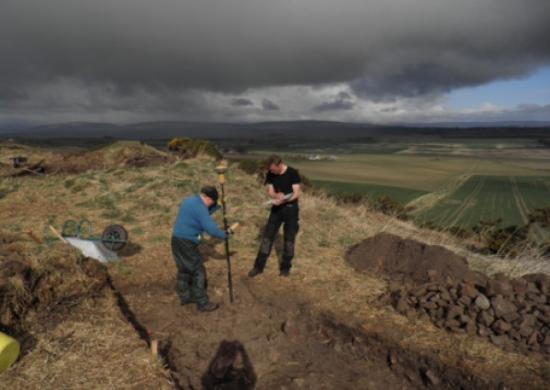Frank Urquhart
Source - http://www.scotsman.com/lifestyle/heritage/new-excavations-to-find-lost-pictish-kingdom-1-2925006

University of Aberdeen
Archaeologists are planning a major dig to uncover one of the lost Kingdoms of the ancient Picts, the tribe of legendary warriors whose empire stretched from Fife to the Moray Firth before they mysteriously vanished from history.
Until recently historians had believed that Fortriu - one of the most powerful Kingdoms of the “painted people” - had been based in Perthshire.
But recent research has now placed the Pictish stronghold much further north to the Moray Firth area.
And it was revealed today that a team of archaeologists from Aberdeen University are to embark on a series of excavations on the Tarbat peninsula in Ross-shire where archaeologists have already uncovered evidence of the only Pictish monastic settlement found in Scotland to date.
A spokesman for Aberdeen University said: “The new project will explore for the first time the archaeology of the most powerful kingdom of the Picts – the kingdom of Fortriu. Over the next four years a programme of fieldwork will target the rich archaeological resource that the Picts and the Kingdom of Fortriu left behind.”
He continued:”As part of an exciting new collaboration, the results of the archaeological work will be displayed at the Tarbat Discovery Centre, which currently displays the results of one of the biggest ever Pictish site excavations – the Pictish monastery at Portmahomack which is thought to be one of the major early churches of the Kingdom of Fortriu.”
Dr Gordon Noble, the director of the Fortriu project, said: “We are incredibly excited about our new links with the Tarbat Discovery Centre and our exciting new initiative on the archaeology of the Tarbat peninsula and wider environs.
“Excavations at Portmahomack uncovered an incredibly rich record of a Pictish monastery in the 7th-9th centuries AD. Our work will put the monastery in its wider context, investigating for the first time the archaeology of the Pictish Kingdom of Fortriu, the most powerful Pictish kingdom that had its powerbase in the Moray Firth region.”
He added: “It combines fieldwork research investigating the emergence of the early kingdoms of Scotland with initiatives that will allow the Discovery Centre to continue to showcase research on the Picts and the heritage of the Tarbat peninsula to a wide audience.”
Further exploration
The team of archaeologists also plan to examine the Pictish cross slabs found at Shandwick, Hilton and Nigg in an attempt to understand the power structures that led to the formation of the early Pictish kingdoms.
Preliminary excavations of a hill fort at Easter Rarichie in Ross and Cromarty have already revealed a remarkable stone-walled structure that may be an important settlement dating to the Iron Age or Pictish period.
Tony Watson, the chairman of Tarbat Discovery Centre said: “The importance of the carved stones is already well-known but they didn’t happen just in isolation but were part of a far bigger picture that started centuries before the monks and Christianity arrived in Portmahomack.
“These are really exciting times for the Centre and the wider area and this long-term research programme should bring many unknown and neglected sites to a wider audience.”
It was revealed two months ago that a recently discovered DNA marker suggests that 10 per cent of Scottish men are directly descended from the Picts. Known as “’Picti’” by the Romans ‘Painted Ones’ in Latin - the empire of Pictish tribes constituted the largest kingdom in Dark Age Scotland. They repelled the conquests of both Romans and Angles before disappearing from history by the end of the first millennium .
The Picts took part in one of the most decisive battles in Scottish history - the Battle of Dun Nechtain , also known as the Battle of Nechtansmere - when the Picts defeated the Northumbrian forces of King Ecgfrith.
Historians have claimed that the Pictish triumph laid the foundations for a distinctive Scottish state, which endured until the Act of Union in 1707.